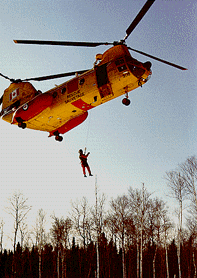Three to a Bag:
Flying Military Search & Rescue Helicopters
(so that others may live!)
![]()
Excerpt from "Pulling Pitch." Stories from
the cockpit of a Canadian Military Helicopter Pilot. A work in progress by
Stéphane Demers.
To be published by "Village Idiot Press."
![]()

ELT SEARCH NEAR
ELLIOT LAKE, ONTARIO
![]() On a late
summer evening in the late 1980s we get called out for an ELT in the Elliot
Lake area. We had launched in our usual team of one Buffalo aircraft and one
Labrador helicopter. The Buff had a crew of two pilots, one navigator, a
flight engineer, a loadmaster and two SARTECHs. On the Lab we had two
drivers, one flight engineer and two SARTECHs.
On a late
summer evening in the late 1980s we get called out for an ELT in the Elliot
Lake area. We had launched in our usual team of one Buffalo aircraft and one
Labrador helicopter. The Buff had a crew of two pilots, one navigator, a
flight engineer, a loadmaster and two SARTECHs. On the Lab we had two
drivers, one flight engineer and two SARTECHs.
The ELT was not very strong and it took quite
some time for the Buff to locate it. By the time they managed to find it we
were close by in the Lab so we got vectored directly into the actual spot
instead of having the SARTECHS parachute in from the Buffalo. The wreckage
was difficult to spot because there really wasn't much left to see that
resembled what was once a nice aircraft. We were able to land in a small
clearing which was a nice switch because many times we spent the whole
rescue in the hover with virtually no single engine capability.
Our SARTECHs reached the wreckage in a couple
of minutes and delivered part of the Notice of Crash Location which was our
standard message format to report our findings at a crash site. They
declared one "black" and two "grey". We used this code
which helped us communicate the condition of those we found without having
to use more common or crude terms and to avoid confusion on the severity of
injuries. The code is simple and not secret by any means. "Green"
means a survivor without injury, "yellow" meant slight injuries
but non life threatening, "red" meant life threatening injuries,
"black" meant they were deceased and then we had "grey"
for undetermined because they were either missing from having left the crash
site or it was undetermined because you could not tell by the remains if you
had a whole person. This was very common at fatal crash sites particularly
if there had been a fire and it was up to the SARTECHs to root through the
crash site and identify enough to tell how many they had.
It seems like a rather gross situation
but it was an all too real part of flying SAR missions and the type of work
our SARTECHs did all the time. They took quite a while at the crash site
then finally said they believed they could recover enough to confirm they
had all three. They were also concerned with not only satisfying that they
had three persons but also appropriate enough remains to positively identify
them so the families could know for sure. People would not often realize how
hard these guys worked to ensure the least amount of suffering for the
surviving family members. We also needed permission from the OPP or the
Coroner's office before removing the remains and it was finally radioed to
us just as the guys returned with the body bag.
We had landed in a confined area on a small
patch of dirt and low grass. The boys finally came back to the aircraft and
we got ready to depart only by now it was dark and we had to do an
Instrument Take Off out of the confined area where we had landed. ITOs were
done because you had no outside reference. All military helo drivers learned
the manoeuvre for taking off out of a snow or dust bowl situation and
especially for night flying. This was long before we had night vision
goggles and it was not unusual for us to land out in the sticks at night so
we had to use this method to get back out.
On the way in to land you had to notice
as many of the obstacles as possible and commit what you saw to memory. It
might be minutes later or perhaps hours before you would leave the confined
area again. So once you are ready to go you pull in power to get the
Labrador light on her wheels, do your final check of the gauges and until
you feel stabilized. When you are ready, you pull max power while
maintaining a zero airspeed, keep the same heading and watch the vertical
speed indicator and your radar altimeter.
Hopefully you weren't drifting from the
vertical and by about 500 feet above what you remembered the obstacles to
be, you start to fly off. Put the nose down five degrees, build your speed
to about 75 knots and then raise the nose to maintain that speed and power
setting. Hopefully you would get a climb of about 1200 or so feet per
minute, and not hit any terrain of course. I know helicopter crews used this
method until NVGs became common in most fleets and to my knowledge no one
ever had an accident using it. It was still a pretty challenging departure
to do right and you really hoped you had been real observant on your way in
and that your altimeter setting had not changed too much since your last
update. There was never a doubt that hitting Cumulus Granite would hurt and
we studiously avoided it.
As we flew out of a very sparsely settled area
we had no way of knowing a thick layer of haze had developed and we spent a
very suspenseful 30-minute flight out of the woods. It was totally IMC but
thankfully we were able to dial in the NDB for the Elliot Lake Airport. Our
only other navigational aid would have been our Omega which most of the time
was pure crap. It wasn't unusual for the Omega to navigate OK for a while
until you slowed down too much or landed and took off again. That use to
confuse the hell out of it because it was really suited for a fixed wing
aircraft and not a machine that could zero it's groundspeed like us. More
than once while I knew I was in Northern Ontario the Omega was telling me I
was off the coast of Bermuda and doing 350 knots groundspeed! A very
unlikely occurrence in the old "Labrador love machine".
We set up for the approach into Elliot Lake
but were glad to see the runway lights from a couple of miles back and made
an uneventful VFR landing on the ramp by the small terminal building. The
whole flight was on the dials right up to then as the airport is quite a
ways out of town. It made for a nerve-wracking evening and on top of the
flying challenges there is the smell. No training on earth can prepare you
for that smell when you are carrying the remains of crash site fatalities
where there was a fire and now it's hours later, hot and humid and you are
tired and stressed already. Some guys had a real hard time with that but it
was all part of the job.
By the time we arrived the Rescue Coordination
Centre staff had contacted the local ambulance service and Ontario
Provincial Police so an ambulance and cruiser would greet us at the airport.
With survivors we would simply lower our aft ramp and hustle them off to the
ambulance. With fatalities there was no need to rush so we just shut down.
Once the rotors stopped the EMT and an OPP came up the aft ramp to assist.
The gal from the ambulance got the picture right away when she saw only one
body bag.
The OPP guy was young and keen, obviously very
excited with the whole situation and this large helo landing at night fresh
off of a daring rescue. He kept asking where they were and he repeatedly
referred to them as survivors. The look on the EMT's face as she tried to
gently break the news to him was of desperation but he still persisted.
Finally the SARTECH Leader couldn't stand it anymore and screamed it out at
him, "Look buddy, all three of 'em are in the damn bag, OK!" It
finally registered with him, he turned pasty white and rushed off our aft
ramp and puked his guts out on the tarmac.
We all shrugged it off of course. I was
becoming accustomed to how the SAR community dealt with such frequent
sadness and death. A mix of black humour and denial or at the very least a
seeming gift for just forgetting the entire events nearly as soon as they
happened. As was often the way with the Lab, the aircraft was unserviceable
the next morning and we spent most of the day waiting for the Buffalo to
bring us parts only to have it nearly crash on landing. I don't remember
what the heck those boys were doing but I remember our crew sitting outside
waiting as the Buffalo came in. The runway at Elliot Lake is slightly
elevated from the surrounding ground but I was still in shock when the Buff
disappeared from view just before touchdown.
They had a done an NDB approach and broke out
of cloud already part way through their downwind leg and chose to do a
modified approach. You could tell they had rushed the circuit and their line
up on final was low, tight and never really set up straight. It scared the
hell out of us when they banked at least 60 degrees and dropped almost
completely out of sight on very short final. The aircraft then roared and
bounded nose up as it lined up and rolled wings level for the runway. Once
over the runway the power chopped, and the aircraft dropped very heavy on
it's gear much to our astonishment.
When they rolled up I couldn't help but ask
them if they were OK and who the hell was driving? They were obviously
embarrassed by it all and especially the aircraft Captain because it was a
fairly new First Officer whom he had allowed to go too far. Scary monsters
but I truly believe we almost saw that aircraft miss the runway that day.
All I could think of was that after picking those three up the night before
I really didn't want to rush to the end of the runway and pick up our own
guys. We got our machine fixed up in short order with those parts and by
late evening we were back at 9 hangar in Trenton.
You would think that guys ran straight home
after a mission like that but most of us would stay and have a couple of
beers to unwind, especially the SARTECHS. To this day I don't really
understand how they do it but I am extremely grateful that they are out
there and willing to do what they do, "So That Others May Live".
God bless them all.
![]()
Note from the Editor. If you liked that - check out Stéphane Demers other story, Right Flight Wrong Rock.
Use the attitude indicator as your guide back to Friends.
Top of this story.
Editor John S Goulet
Last modified on
March 05, 2006 .
© Virtual Horizons, 1996.